Reminiscences of Ramakrishna Nagendra Nath Gupta |
||
(Ramakrishna Paramahamsa) was practically an unlettered man like some of the great prophets of old, and by occupation he was the priest of a temple, a vocation for which he became unfit later on. Ignorant people thought his mind was giving way, but in reality it was a struggle of the spirit seeking true knowledge and finding its expression. And when this was attained, he no longer avoided men, and drew around him a small band of earnest young men who sought for guidance from him and endeavored to follow his teachings. Many of his sayings have been collected and published, but these give only a faint indication of his individuality. It may be said with absolute truth that he was one of the elect who appear at long intervals in the world for some great purpose. It has been my privilege to hear him speak; and I felt then, as I feel now, that it is only rarely that men have the great good fortune of listening to such a man. The Paramahamsa's language was Bengali of a homely kind; he was not supple of speech as he spoke with a slight though delightful stammer, but his words held men enthralled by the wealth of spiritual experience, the inexhaustible store of simile and metaphor, the unequalled powers of observation, the bright and subtle humor, the wonderful catholicity of sympathy and the ceaseless flow of wisdom. Ramakrishna Paramahamsa frequently passed into a trance or samadhi, The exciting cause was invariably some spiritual experience or some new spiritual perception. On one occasion — it was in 1881 — I formed one of a party that had gone with Keshab Chandra Sen by river to see the Paramahamsa. He was brought on board our steamer, which belonged to Maharaja Nripendra Narayan Bhup of Cooch Behar , Keshab's son-in-law. The Paramahamsa, as is well known, was a worshipper of the goddess Kali; but he was also an adept in the contemplation of Brahman the formless, nirakara, and had some previous conversation with Keshab on this subject. He was sitting close to Keshab facing him, and the conversation was practically a monologue, for either Keshab or some one else would put a brief question and, in answer, the Paramahamsa with his marvellous gift of speech and illustration would hold his hearers entranced. All of us there hung breathless upon his words. And gradually the conversation came round to nirakara (formless) Brahman, when the Paramahamsa, after repeating the word nirakara two or three times to himself, passed into a state of samadhi. Except the rigidity of the body there was no quivering of the muscles or nerves, no abrupt or convulsive movement of any kind. The fingers of the two hands as they lay in his lap were slightly curled. But a most wonderful change had come over the face. The lips were slightly parted as if in a smile, with the gleam of the white teeth in between. The eyes were half closed with the balls and pupils partly visible, and over the whole countenance was an ineffable expression of the holiest and most ecstatic beatitude. We watched him in respectful silence for some minutes after which Trailokya Nath Sanyal, known as the singing apostle in Keshab Chandra Sen's sect, sang a hymn to the accompaniment of music, and the Paramahamsa slowly opened his eyes, looked inquiringly around him for a few seconds and then resumed the conversation. No reference was made either by him or any one else to his trance.
On another occasion the Paramahamsa wanted to see the Zoological Gardens of Calcutta. His eagerness was like a child's and would not brook any delay. There were times when his ways were strongly reminiscent of the saying in the Shrimad-Bhagavata that the mukta, the emancipated and the wise, is to be known by his childlike playfulness. A cab was sent for and the Paramahamsa, accompanied by some disciples, was driven the long distance from Dakshineswar to Alipur. When he entered the Gardens, the people with him began showing him the various animals and aquatic collections, but he would not even look at them. "Take me to see the lion," he insisted. Standing in front of the lion's cage he mused. "This is the Mother's mount" — the goddess Kali in the form of Durga or Parvati is represented as riding a lion — and straightway passed into samadhi. He would have fallen but for the supporting arms around him. On regaining consciousness, he was invited to stroll round the Gardens and see the rest of the collection. "I have seen the king of the animals. What else is there to see?" replied the Paramahamsa. And he went back to the waiting carriage and drove home. There seems to be an obvious incongruity between the predisposing causes of samadhi on these two occasions. On the first, it was the contemplation of the nirakara Brahman, a high and abstruse spiritual concept; on the second, it was merely the sight of a caged lion. But in both instances the process of the concentration of the mind and the spirit is the same. In one, it is the intense realization of the supreme Brahman without form; in the other, it is a realization in the spirit of a visual symbolism inseparably associated with the goddess Kali. In both cases a single spiritual thought occupies the mind to the exclusion of everything else, obliterates the sense of the objective world, and leads to samadhi. No photograph taken of the Paramahamsa in samadhi ever succeeded in reproducing the inward glow, the expression of divine ecstasy, brahmananda, stamped on the countenance.
|
- www.vivekananda.net edited by Frank Parlato Jr.

